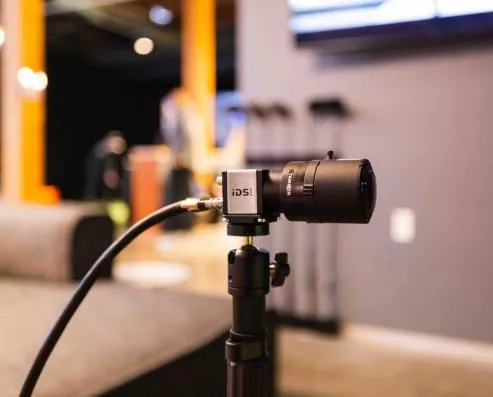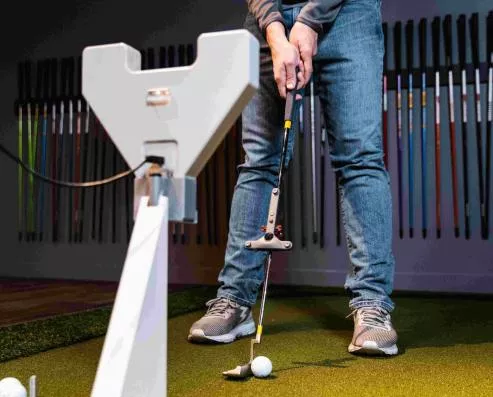[vc_row][vc_column][vc_column_text c_id=”.vc_1639432695834″]Matt Decker – Baltimore
As both a teaching professional and a club fitter, I am in a unique position to observe and influence a player’s game with both equipment and swing changes. Part of my teaching philosophy is the importance of having properly fitting clubs, particularly when the goal we are trying to achieve is improvement. The idea that money can’t buy you a game is a bit of a misconception — clubs that are improperly fit can surely be a detriment to your game.
We will walk through the important aspects of your bag and see if you identify any areas that may need to be addressed.
Shaft Weight and Flex
When looking at a player’s bag, club heads may be the first thing I see, but the shaft type and details of the shaft are the first things I look for. Whether it be the material, the weight, the flex, or the profile of the shaft, all of these things should be based on that individual. When assessing a players shaft, I first look at material — steel or graphite? — and try to see if it matches their swing (or, more importantly, if it doesn’t).
Graphite is no longer just for slower swing speeds; with the technology being used, even the fastest swings in the world can be fit into graphite. The main difference between steel and graphite will be weight. With the traditional steel shaft being around 125 grams, and graphite now getting as low as 30 grams, the player can be set up for failure early in our assessment.
Shaft weight can do several things to your swing. A heavy shaft can slow down swing speed, create an acceleration issue in the swing sequence, and change the ball flight. The shaft flex can also influence the ball’s flight. A shaft that is too soft or too firm will tend to fly offline more often than one which has been fit correctly.
Club Head Type
Matching the club head to your skill level and playing style is also very important. With irons, there are now several categories: game improvement, players distance, muscleback, and cavity back. If you’re a player with a slower swing speed who is an inconsistent ball striker, a larger iron profile, like a game improvement iron, will be more forgiving, launcher higher, and spin less, to help that area of your game.
For driver heads, you can choose between adjustability, forgiveness, MOI, and ball speed preferences thanks to current technology. Getting the proper model that encourages you to become better by growing with swing changes is significantly preferred over altering numbers to fix problems in the short term.
Lie Angle
A club’s lie angle will determine the interaction the club has as it enters the turf at contact. Very often students come in with clubs off the rack and have no idea what the lie angle of the club is or if it is correctly fit for them. If the lie angle is too upright (toe high), the heel of the club may dig at contact, causing the face to close down and the ball to start left. If the club is too flat (toe down), the toe of the club could dig and the ball would start right of target.
The lie angle is also a contributing factor of centeredness of contact. With an iron that is too upright, the contact may be more towards the heel; with an iron that is too flat, the contact may tend to be more towards the toe. When working on your game, having equipment that can alter the start line of your shots could persuade you to work on something that isn’t a swing flaw, but rather a fitting error.
Set Make Up
I think there is a common misconception that because the USGA allows a golfer to carry 14 clubs in his or her bag, then a golfer must carry and use 14 clubs when he or she plays. When conducting a pre-lesson interview, I like to ask students which of their clubs is their most favorite and their least favorite. The general consensus is that the favorite club is between a 7 iron and a pitching wedge, and the least favorite is anything longer than a 5 iron. Why? Because in the longer clubs there are multiple clubs that may perform similarly… For example, if a player hits a driver 200 yards, their yardage gaps may not differ by more than five or six yards between some clubs, making a number of clubs obsolete.
When fitting a beginner, or if there is a financial barrier that we’re trying to stay below, creating a partial set allows for the golfer’s needs to be met while keeping the quality of the clubs at a premium. In other cases, if a student has difficulty with a certain type of club — say a fairway wood — it’s good to analyze if that club is even necessary. Does it hold any benefits for that student, or is it just costing them strokes.
Staying with fairways woods… If a player has a 3 wood, a 5 wood, and possibly a couple of hybrids, but only hits the 5 wood well, I would recommend that they try playing without the other three clubs. For amateur golfers, the amount of times they may need to hit the ball into a green from that distance would be low, assuming the lie allows for those clubs to be hit in those situations and that it is the right play into the green they would be attacking.
When students come to me with a goal of improving their game, I often tell them that there will need to be changes in equipment to see results. We don’t need to break the bank, but getting your set up assessed by your teaching or fitting professional can shave strokes off your game. When investing in your golf swing, take some time to make sure that you aren’t losing out due to improperly fit equipment.
You can book a lesson with Matt in Baltimore by clicking here. [/vc_column_text][vc_empty_space][vc_empty_space][/vc_column][/vc_row]

